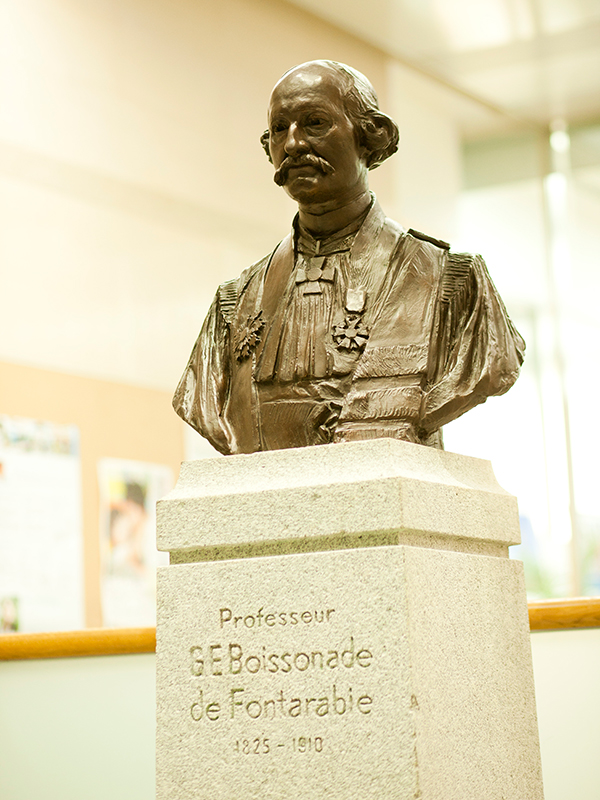History of Hosei University (HOSEI Museum)
History of Hosei University in the Founding Spirit
History of Hosei University (HOSEI Museum)Birth of Tokyo Hogakusha
The history of Hosei University dates back to 1880 (Meiji 13th year), when the Tokyo Hogakusha was founded at 19 Kitakoga-cho, Surugadai, Tokyo, by a group of native lawyers, including Tetsu Kanamaru, Osamu Ito, and Masakuni Sattva. The birth of the Tokyo Hogakusha was in response to the new momentum in Japan at the time, when the liberal civil rights movement was in full swing and the modern legal system was beginning to be developed.
From its inception, Tokyo Hogakusha was not a "school" but a "school" for the training of legal professionals, and the spirit of practical education, or career education, that has been handed down to this day was also a part of the school's founding. The spirit of practical education, or career education, which has been handed down to this day, can be said to have originated from the very beginning.

A bust of Dr. Boissonade, who made great contributions to the education of the university.
The Spirit of Freedom and Progress
The spirit of "liberty and progress" can be traced back to the spirit of French law.
Most of the people involved in the establishment of Tokyo Hogakusha, including Satto, were students of Boissonade, a professor at the University of Paris who was invited from France to serve as a legal advisor to the government at the time.
Boissonade is known for introducing the idea of natural law to Japan, drafting the Civil Code, the Penal Code, and the Crimes Control Law, as well as training many lawyers.
In 1881 (Meiji 14), when private law schools were banned, the Tokyo Law School closed its "Dogenbureau," and the "Koho Bureau" became independent and named itself the Tokyo Law School, and in 1883 (Meiji 16), Boissonade was appointed its head teacher.
In 1889, the school merged with the Tokyo French School, which had been established by the French Society in 1886, and changed its name to the Franco-Japanese Law School.
Dr. Kenjiro Ume
In 1899, when Kenjiro Ume became principal, the school opened the "Advanced Course" for recurrent education for graduates and others, and the "Voluntary Course" for language education in English, German, and French, as well as introducing the "trainee" system, in which non-working students could study independently using textbooks published by the school, and the "auditing student" system and "preferential student" system. The school also introduced a "course student" system for non-working students to study independently using textbooks published by the school, as well as an "auditing student" system and a "preferential student" system.
The reforms bore fruit, and in 1903 (1903), based on the foundation of the reforms, the school was renamed Hosei University, a Japanese-French law school foundation, in accordance with the Senmon Gakko Ordinance. The new school had a preparatory course for daytime classes, a university and specialized courses for evening classes, and a graduate school of advanced studies, and Ume was appointed as the first prime minister ( President.
The spirit of the educational reforms that originated in Ume's originality, with the philosophy and purpose of "open education," is also something that the university still relies on today.
The Birth of Hosei University
In 1918, the University Ordinance was issued, authorizing the establishment of a private university.
In 1920, Hosei University was established as an incorporated foundation. This was the birth of Hosei University in its present-day name and form.
Initially, Faculty of Law University consisted of the Faculty of LawFaculty of Economics, which were joined by the Faculty of Preparatory Studies and the Faculty of Professional Studies.
In 1921, a new school building was built in Fujimi-cho 4-chome, Kojimachi-ku (current location), and the school moved to this location.
In 1922, the Faculty of Law and Faculty of Letters was established with the addition of Department of Philosophy Literature and the Department of Philosophy to the Faculty of Law.
During this period, the faculty organization shifted from lecturers to full-time faculty members, and the teaching style changed from night classes to day classes, and Hosei University began to take on the appearance of a university.
Today, Hosei University is a university with 15 faculties, a School of Correspondence Education, 14 graduate schools and 4 institutes, and 2 professional graduate schools.

